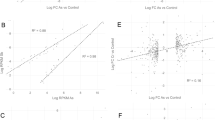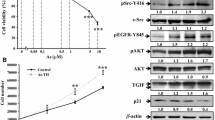Abstract
Arsenite is a human carcinogen that may induce cancer in skin, liver, kidney, bladder or lung. Arsenite executes its toxic effects by the induction of signaling cascades. In particular, the activation of the stress-induced protein kinase c-Jun N-terminal protein kinase and p38 and the phosphorylation and activation of the transcription factor c-Jun have been linked to the biological effects of arsenite. We analyzed whether arsenite has an impact on the biosynthesis of the zinc finger transcription factor Egr-1. Egr-1 transcription is upregulated following treatment of cells with hormones, cytokines or toxic chemicals, and thus Egr-1 integrates many signaling cascades with changes in gene expression patterns. Here, we show by Western blot experiments that arsenite induces a transient synthesis of Egr-1 in human HaCaT keratinocytes. Egr-1 biosynthesis was activated by arsenite concentrations insufficient for the induction of c-Jun biosynthesis. This arsenite-triggered Egr-1 biosynthesis was completely inhibited by the mitogen-activated protein kinase kinase inhibitor PD98059 and by AG1487, an epidermal growth factor (EGF) receptor-specific tyrosine kinase inhibitor. These results indicate that activation of the EGF receptor as well as stimulation of the mitogen activated/extracellular signal-regulated protein kinase is essential for arsenite-induced upregulation of Egr-1. Moreover, we detected an elevated transcriptional activation potential of the ternary complex factor Elk1, a key transcriptional regulator of serum response element-driven gene transcription. The Egr-1 5′-flanking region contains five serum response elements. Accordingly, we observed an increase in Egr-1 promoter activity as a result of arsenite treatment. The fact that low concentrations of arsenite are sufficient to induce Egr-1 biosynthesis suggests that Egr-1 may be an integral part of arsenite-triggered signaling cascades leading to tumor formation or cell death via alterations of the cellular genetic program.




Similar content being viewed by others
References
Smith AH, Lopipero PA, Bates MN, Steinmaus CM (2002) Public health. Arsenic epidemiology and drinking water standards. Science 296:2145–2146
Hartwig A, Groblinghoff UD, Beyermann D, Natarajan AT, Filon R, Mullenders LH (1997) Interaction of arsenic(III) with nucleotide excision repair in UV-irradiated fibroblasts. Carcinogenesis 18:399–405
Shao W, Fanelli M, Ferrara FF, Riccioni R, Rosenbauer A, Davison K, Lamph WW, Waxman S, Pelicci PG, Lo Coco F, Avvisati G, Testa U, Peschle C, Gambacorti-Passerini C, Nervi C, Miller WH Jr (1998) Arsenic trioxide as an inducer of apoptosis and loss of PML/RARα protein in acute promyelocytic leukemia cells. J Natl Cancer Inst 90:124–133
Chen Y-C, Lin-Shiau S-Y, Lin J-K (1998) Involvement of reactive oxygen species and caspase 3 activation in arsenite-induced apoptosis. J Cell Physiol 177:324–333
Zhu X-H, Shen Y-L, Jing Y-K, Cai X, Jia P-M, Huang Y, Tang W, Shi G-Y, Sun Y-P, Dai J, Wang Z-Y, Chen S-J, Zhang T-D, Waxman S, Chen Z, Chen G-Q (1999) Apoptosis and growth inhibition in malignant lymphocytes after treatment with arsenic trioxide at clinically achievable concentrations. J Natl Cancer Inst 91:772–778
Namgung U, Xia Z (2000) Arsenite-induced apoptosis in cortical neurons is mediated by c-Jun N-terminal protein kinase 3 and p38 mitogen-activated protein kinase. J Neurosci 20:6442–6451
Ling Y-H, Jiang J-D, Holland JF, Perez-Soler R (2002) Arsenic trioxide produces polymerization of microtubules and mitotic arrest before apoptosis in human tumor cell lines. Mol Pharmacol 62:529–538
Kitchin KT (2001) Recent advances in arsenic carcinogenesis: modes of action, animal model systems, and methylated arsenic metabolites. Toxicol Appl Pharmacol 172:249–261
Schwartz RA (1997) Arsenic and the skin. Int J Dermatol 36:241–250
Germolec DR, Spalding J, Boorman GA, Wilmer, JL, Yoshida T, Simeonova PP, Bruccoleri A, Kayama F, Gaido K, Tennant R, Burleson F, Dong W, Lang RW, Luster MI (1997) Arsenic can mediate skin neoplasia by chronic stimulation of keratinocyte-derived growth factors. Mut Res 386:209–218
Germolec DR, Spalding J, Yu H-S, Chen GS, Simeonova PP, Humble MC, Bruccoleri A, Boorman GA, Foley JF, Yoshida T, Luster MI (1998) Arsenic enhancement of skin neoplasia by chronic stimulation of growth factors. Am J Pathol 153:1775–1785
Hei TK, Liu SX, Waldren C (1998) Mutagenicity of arsenic in mammalian cells: role of reactive oxygen species. Proc Natl Acad Sci USA 95:8103–8107
Cavigelli M, Li WW, Lin A, Su B, Yoshika K, Karin M (1996) The tumor promoter arsenite stimulates AP-1 activity by inhibiting a JNK phosphatase. EMBO J 15:6269–6279
Liu Y, Guyton KZ, Gorospe M, Xu Q, Lee JC, Holbrook NJ (1996) Differential activation of ERK, JNK/SAPK and p38/CSBP/RK MAP kinase family members during the cellular response to arsenite. Free Radic Biol Med 21:771–781
Liu SX, Athar M, Lippai I, Waldren C, Hei TK (2001) Induction of oxyradicals by arsenic: implication for mechanism of genotoxicity. Proc Natl Acad Sci USA 98:1643–1648
Lynn S, Shiung J-N, Gurr J-R, Jan KY (1998) Arsenite stimulates poly(ADP-ribosylation) by generation of nitric oxide. Free Radic Biol Med 24:442–449
Boukamp P, Petrussevska RT, Breitkreutz D, Hornung J, Markham A, Fusenig NE (1988) Normal keratinocytes in a spontaneously immortalized aneuploid human keratinocyte cell line. J Cell Biol 106:761–771
Thiel G, Cibelli G (2002) Regulation of life and death by the zinc finger transcription factor Egr-1. J Cell Physiol 19:287–292
Rolli M, Kotlyarov A, Sakamoto KM, Gaestel M, Neininger A (1999) Stress-induced stimulation of early growth response-1 by p38/stress-activated protein kinase 2 is mediated by a cAMP-responsive promoter element in a MAPKAP kinase-2 independent manner. J Biol Chem 274:19559–19564
Souza K, Maddock DA, Zhang Q, Chen J, Chiu C, Mehta S, Wan Y (2001) Arsenite activation of PI3K/AKT cell survival pathway is mediated by p38 in cultured human keratinocytes. Mol Med 7:767–772
Kaufmann K, Thiel G (2002) Epidermal growth factor and thrombin induced proliferation of immortalized human keratinocytes is coupled to the synthesis of Egr-1, a zinc finger transcriptional regulator. J Cell Biochem 85:381–391
Thiel G, Kaufmann K, Magin A, Lietz M, Bach K, Cramer M (2000) The human transcriptional repressor protein NAB1: expression and biological activity. Biochim Biophys Acta 1493:289–301
Groot M, Boxer LM, Thiel G (2000) Nerve growth factor and epidermal growth factor regulated gene transcription in PC12 pheochromocytoma and INS-1 insulinoma cells. Eur J Cell Biol 79:924–935
Chen W, Martindale JL, Holbrook NJ, Liu Y (1998) Tumor promoter arsenite activates extracellular signal-regulated kinase through a signaling pathway mediated by epidermal growth factor receptor and Shc. Mol Cell Biol 18:5178–5188
Dudley DT, Pang L, Decker SJ, Bridges AJ, Saltiel AR (1995) A synthetic inhibitor of the mitogen-activated protein kinase cascade. Proc Natl Acad Sci USA 92:7686–7689
Simeonova PP, Wang S, Toriuma W, Kommineni V, Matheson J, Unimye N, Kayama F, Harki D, Ding M, Vallyathan V, Luster MI (2000) Arsenic mediates cell proliferation and gene expression in the bladder epithelium: association with activating protein-1 transactivation. Cancer Res 60:3445–3453
Rodeck U, Jist M, Kari C, Shih D-T, Lavker RM, Ewert DL, Jensen PJ (1997) EGF-R dependent regulation of keratinocyte survival. J Cell Sci 110:113–121
Stoll SW, Benedict M, Mitra R, Hiniker A, Elder JT, Nuñez G (1998) EGF receptor signaling inhibits keratinocyte apoptosis: evidence for mediation by Bcl-XL. Oncogene 16:1493–1499
Gibson S, Tu S, Oyer R, Anderson SM, Johnson GL (1999) Epidermal growth factor protects epithelial cells against Fas-induced apoptosis. J Biol Chem 274:17612–17618
Jost M, Huggett TM, Kari C, Boise LH, Rodeck U (2001) Epidermal growth factor receptor-dependent control of keratinocyte survival and Bcl-xL expression through a MEK-dependent pathway. J Biol Chem 276:6320–6326
Ludwig S, Hoffmeyer A, Goebeler M, Kilian K, Häfner H, Neufeld B, Han J, Rapp UR (1998) The stress inducer arsenite activates mitogen-activated protein kinases extracellular signal-regulated kinases 1 and 2 via a MAPK kinase 6/p38-dependent pathway. J Biol Chem 273:1917–1922
Huang C, Ma W-Y, Li J, Dong Z (1999) Arsenite induces apoptosis through a c-Jun NH2 terminal kinase-dependent, p53-independent pathway. Cancer Res 59:3053–3058
Kim J-Y, Choi J-A, Kim T-H, Yoo Y-D, Kim J-I, Lee YJ, Yoo S-Y, Cho C-K, Lee Y-S, Lee S-J (2002) Involvement of p38 mitogen-activated protein kinase in the cell growth inhibition by sodium arsenite. J Cell Physiol 190:29–37
Huang C, Ma W-Y, Li J, Goranson A, Dong Z (1999) Requirement of Erk, but not JNK, for arsenite-induced cell transformation. J Biol Chem 274:14595–14601
Schmidt M, Goebeler M, Posern G, Feller SM, Seitz CS, Bröcker E-B, Rapp UR, Ludwig S (2000) Ras-independent activation of the Raf/MEK/ERK pathway upon calcium induced differentiation of keratinocytes. J Biol Chem 275:41011–41017
Lim CP, Jain N, Cao X (1998) Stress-induced immediate-early, Egr-1, involves activation of p38/JNK1. Oncogene 16:2915–2926
Sgambato V, Vanhoutte P, Pagès C, Rogard M, Hipskind R, Besson M-J, Caboche J (1998) In vivo expression and regulation of Elk-1, a target of the extracellular-regulated kinase signaling pathway, in the adult rat brain. J Neurosci 18:214–226
Cibelli G, Policastro V, Rössler OG, Thiel G (2002) Nitric oxide-induced programmed cell death in human neuroblastoma cells is accompanied by the synthesis of Egr-1, a zinc finger transcription factor. J Neurosci Res 67:450–460
Rössler OG, Thiel G (2004) Brain-derived neurotrophic factor, epidermal growth factor, or A-Raf induced growth of HaCaT keratinocytes requires extracellular signal-regulated kinase. Am J Physiol Cell Physiol 286:C1118–C1129
Riggs PK, Rho O, DiGiovanni J (2000) Alteration of Egr-1 mRNA during multistage carcinogenesis in mouse skin. Mol Carcinogen 27:247–251
Liu C, Rangnekar VM, Adamson E, Mercola D (1998) Suppression of growth and transformation and induction of apoptosis by Egr-1. Cancer Gene Ther 5:3–28
Acknowledgements
We thank N.E. Fusenig for his generous gift of HaCaT cells, and Libby Guethlein and Oliver Rössler for critical reading of the manuscript. This work was supported by the “Universität des Saarlandes”.
Author information
Authors and Affiliations
Corresponding author
Rights and permissions
About this article
Cite this article
Al-Sarraj, A., Thiel, G. The zinc finger transcription factor Egr-1 is upregulated in arsenite-treated human keratinocytes. J Mol Med 82, 530–538 (2004). https://doi.org/10.1007/s00109-004-0545-0
Received:
Accepted:
Published:
Issue Date:
DOI: https://doi.org/10.1007/s00109-004-0545-0




